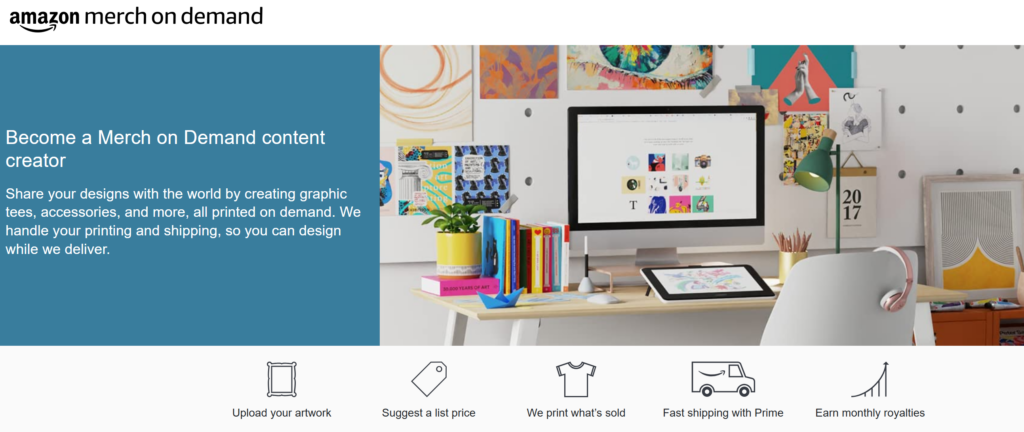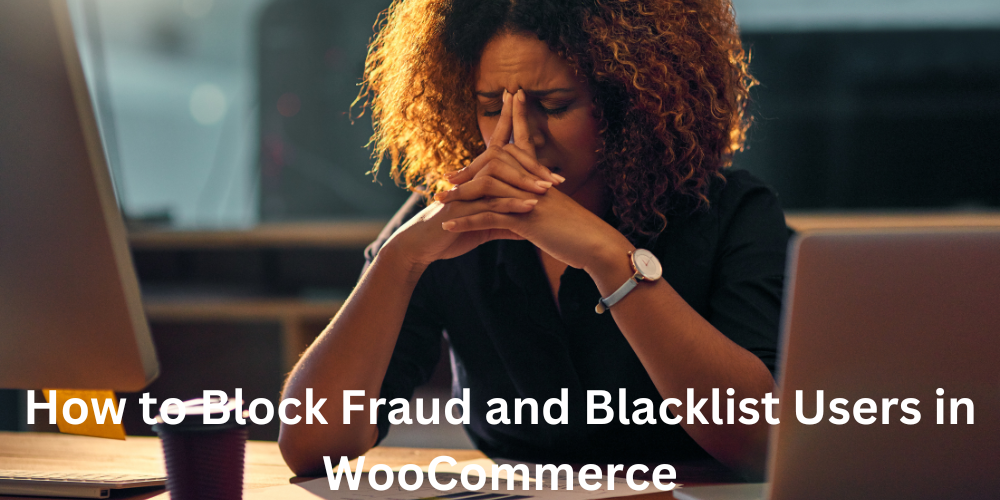Amazon Merch on Demand, formerly known as Merch by Amazon, is a print-on-demand service that allows individuals and businesses to create and sell custom merchandise directly through Amazon’s marketplace. This platform eliminates the need for upfront investments, inventory management, or handling logistics, making it an attractive option for designers, entrepreneurs, and content creators.

Key Features
1. Easy-to-Use Platform
- Users can upload their designs, select product types and colors, set prices, and publish them for sale.
- Amazon takes care of production, shipping, and customer service.
2. No Upfront Costs
- There are no initial fees or inventory requirements, making it accessible to anyone looking to start an online merchandise business.
3. Prime Shipping Eligibility
- Products are eligible for Amazon Prime, ensuring fast delivery and an enhanced shopping experience for customers.
4. Global Marketplace Access
- Sellers can reach millions of Amazon customers worldwide, increasing their potential for sales and brand growth.
5. Royalty Earnings
- Sellers earn royalties on each sale based on the product’s selling price and associated costs.
Benefits
1. Passive Income Potential
- Once a design is uploaded and approved, sellers can earn money with minimal ongoing effort. Amazon handles the operational aspects, allowing for a hands-off approach.
2. Low Financial Risk
- The print-on-demand model removes the need for large investments in stock, reducing financial risks.
3. Scalability
- As sales increase, sellers unlock higher tiers, allowing for more design submissions and an expanded product catalog.
4. Brand Growth Opportunities
- Amazon’s vast customer base provides an opportunity to build a brand with minimal marketing efforts.
Considerations
1. Application Process
- Access to Amazon Merch on Demand requires an application and approval, which may take time and is not guaranteed.
2. Strict Content Guidelines
- Designs must adhere to Amazon’s content policies, ensuring they do not violate intellectual property rights or contain prohibited content.
3. High Competition
- The platform is competitive, requiring high-quality, unique designs and effective marketing strategies to stand out. For more design resources and tools, visit Podia to enhance your creative journey.
How does Amazon Merch compare to other print-on-demand platforms?
Amazon Merch on Demand is a popular print-on-demand (POD) platform, but it differs significantly from competitors like Printify and Printful in terms of audience reach, ease of use, customization options, and pricing models. Below is an overview comparing Amazon Merch with other platforms:
Amazon Merch on Demand Overview
Amazon Merch on Demand allows sellers to upload custom designs that are printed on various products (e.g., t-shirts, hoodies, phone cases). Amazon handles printing, fulfillment, and shipping, enabling sellers to earn royalties without upfront costs or inventory management. The platform is exclusive and operates on an invitation-only basis.
Key Features:
- Access to Amazon’s massive marketplace.
- Products eligible for Amazon Prime shipping.
- Passive income model with no storage or fulfillment costs.
- Limited customization options compared to competitors.
Benefits of Amazon Merch
- Massive Audience: Sellers benefit from Amazon’s built-in customer base, making it easier to generate sales without external marketing efforts.
- Prime Eligibility: Products listed as Prime items enjoy faster shipping and greater visibility.
- No Upfront Costs: Sellers avoid expenses related to inventory or fulfillment, making it ideal for passive income seekers.
Drawbacks Compared to Competitors
- Exclusivity: Invitation-only access limits availability for new sellers.
- Limited Product Range: Focuses mainly on apparel and accessories, unlike competitors offering broader categories like homeware or specialty items.
- Customization Restrictions: Sellers have less control over branding and pricing compared to platforms like Printify and Printful that allow storefront creation and flexible pricing models.
Check out Pond5 for a wide range of creative assets, including stock footage, music, and digital design resources to enhance your projects.
How does the royalty structure of Amazon Merch compare to other platforms?
Amazon Merch on Demand and other print-on-demand (POD) platforms, such as Printful and Printify, have distinct royalty and pricing models. Below is a detailed comparison:
Amazon Merch Royalty Structure
- Predetermined Royalties: Amazon Merch offers royalties ranging from approximately 12% to 38% of the product’s sale price, depending on the item and its price point.
- Base Costs: Amazon deducts costs for materials, production, fulfillment, customer service, fraud prevention, and returns before calculating royalties.
- Tier System: Sellers start with limited designs (e.g., Tier 10) and can move up as sales increase. Higher tiers allow more designs and potential earnings.
- No Pricing Flexibility: Amazon sets base prices for products, limiting sellers’ control over profit margins.
Printful Royalty Structure
- Cost-Plus Pricing Model: Printful allows sellers to set their own retail prices above the base cost of production and shipping. For example, if the base cost of a t-shirt is $9.25 with $2.20 shipping, sellers can price it at $19.99 to earn $11.59 per sale.
- Complete Pricing Control: Sellers have full flexibility to determine profits by adjusting retail prices.
- White-Label Branding: Printful enables sellers to create branded storefronts, unlike Amazon Merch’s fixed branding under the Amazon label.
Printify Royalty Structure
- Similar to Printful, Printify uses a cost-plus pricing model.
- Sellers can choose from multiple print providers with varying base costs, offering flexibility in pricing and profit margins.
- Allows integration with external marketplaces like Etsy or Shopify for broader reach.
Benefits of Amazon Merch’s Royalty Model
- Simplified Earnings: Sellers receive royalties without managing production or fulfillment logistics.
- Passive Income: Once designs are uploaded, they remain evergreen listings eligible for royalties indefinitely.
- Prime Shipping: Products benefit from fast shipping under Amazon Prime, enhancing customer appeal.
Are there any unique features of Amazon Merch that other platforms don’t offer?
Amazon Merch on Demand stands out among print-on-demand (POD) platforms due to several unique features that leverage Amazon’s vast ecosystem and infrastructure. Here’s an overview of its distinctive aspects:

1. Seamless Integration with Amazon Marketplace
- Products created through Merch by Amazon are automatically listed on the Amazon marketplace, giving sellers access to millions of active customers worldwide.
- Listings benefit from Amazon’s brand recognition and trust, which can lead to higher conversion rates without requiring sellers to establish their own storefronts.
2. Prime Shipping Eligibility
- Merchandise sold through Amazon Merch is eligible for Amazon Prime shipping, offering customers fast and reliable delivery options. This feature enhances product visibility and appeal compared to competitors.
3. Passive Income Model
- Once designs are uploaded and approved, they remain as evergreen listings on the platform, allowing sellers to earn royalties indefinitely without additional effort or marketing.
- Amazon handles production, fulfillment, customer service, and returns, enabling sellers to focus solely on design and niche targeting.
4. Zero Upfront Costs
- Unlike many POD platforms that charge for production or inventory upfront, Amazon Merch operates entirely on a royalty-based model. Sellers pay nothing initially and earn a commission for each sale.
- This eliminates financial risks associated with inventory management or unsold stock.
5. Global Reach
- Merch by Amazon provides access to multiple international marketplaces, allowing sellers to reach a global audience without additional integrations or tools.
6. Simplified Design Process
- The platform offers design templates and a built-in design editor that helps sellers create mock-ups and ensure artwork fits product specifications. These tools simplify the process for beginners who may not have advanced graphic design skills.
7. Brand Association with Amazon
- Products sold through Merch by Amazon carry the Amazon label, benefiting from the platform’s established trustworthiness and credibility in e-commerce.
- Unlike competitors like Printful or Printify, which allow white-label branding, this feature ensures instant customer confidence without requiring sellers to build their own brand reputation.
How does the customer base of Amazon Merch differ from other platforms?
The customer base of Amazon Merch on Demand differs significantly from other print-on-demand (POD) platforms like Printful and Printify due to Amazon’s unique marketplace integration, global reach, and brand trust. Below are the key distinctions:
Amazon Merch on Demand Customer Base
- Massive Built-In Audience:
- Amazon Merch taps into Amazon’s existing customer base, comprising hundreds of millions of active shoppers worldwide.
- Customers are already familiar with Amazon’s platform, making them more likely to trust and purchase products listed under the Amazon label.
- Global Reach:
- Products are available across multiple international marketplaces, allowing sellers to reach a diverse audience without additional integrations or marketing efforts.
- Amazon’s localized shipping infrastructure ensures faster delivery times, enhancing customer satisfaction globally.
- Prime Members:
- Many customers are Amazon Prime members who prefer products eligible for Prime shipping. This feature increases visibility and appeal compared to competitors that lack such integration.
- Impulse Buyers:
- Shoppers on Amazon often search for specific items and make quick purchasing decisions. This contrasts with platforms like Printful or Printify, where customers may browse branded storefronts or niche marketplaces more deliberately.
Other POD Platforms (Printful, Printify) Customer Base
- Niche Audiences:
- These platforms rely on sellers to drive traffic through external integrations (e.g., Shopify, Etsy) or independent marketing efforts. The customer base is often niche-specific and tailored to individual brands.
- Sellers can build their own brand identity, attracting loyal customers who value personalized branding.
- Brand-Conscious Shoppers:
- Customers on these platforms tend to seek unique or boutique items rather than mass-market products. White-label branding allows sellers to target audiences who prioritize exclusivity and design originality.
- Smaller Reach:
- Without the global marketplace of Amazon, sellers must rely on their own promotional strategies to grow their audience. This limits access to the scale of Amazon’s customer base.
What are the main challenges sellers face on Amazon Merch compared to other platforms?
Selling on Amazon Merch on Demand presents unique challenges that differentiate it from other print-on-demand (POD) platforms like Printful and Printify. Below is an overview of these challenges:
1. Intense Competition
- Market Saturation: Amazon hosts millions of sellers, making it difficult for new entrants to gain visibility in saturated product categories.
- Price Wars: Sellers often engage in price wars to remain competitive, which can drastically reduce profit margins.
- Copycat Designs: Amazon’s open marketplace increases the risk of imitation designs, diluting brand identity and sales potential.
2. Limited Branding Opportunities
- Standardized Listings: Amazon Merch restricts sellers from customizing storefronts or branding their products, unlike platforms like Printful that offer white-label branding options.
- Generic Marketplace: Products are sold under the Amazon label, making it harder for sellers to build a distinct brand presence.
3. High Fees
- Amazon Merch deducts production, fulfillment, and other costs before calculating royalties. These fees can significantly impact profitability, especially for low-priced items.
- Sellers cannot set their own prices or control profit margins as they can on platforms like Printify or Printful.
4. Dependence on Amazon’s Ecosystem
- Algorithm Changes: Visibility is heavily influenced by Amazon’s algorithms, which can change unpredictably and impact sales performance.
- Competition with Amazon’s Private Labels: Amazon competes directly with sellers by offering similar products under its own brands, further reducing market share for third-party sellers.
5. Limited Customer Interaction
- Sellers cannot directly communicate with customers or build relationships due to restrictions on customer data access. This limits opportunities for personalized service and brand loyalty development.
- Feedback is primarily reliant on Amazon’s review system, making it harder to proactively address issues or gather insights.
6. Strict Product Guidelines
- Amazon enforces strict rules regarding product categories and design approvals. Sellers may face rejection or restrictions when attempting to list certain items, which limits flexibility compared to other POD platforms.
7. Consumer-Friendly Return Policies
- Amazon’s lenient return policies favor customers but can lead to higher return rates and additional costs for sellers. Fraudulent returns are also a concern.
Merch Amazon Partnered or Affiliated Program
Amazon Merch on Demand does not have a traditional “partnered” or “affiliated” program in the sense of an affiliate marketing structure like the Amazon Associates Program. However, it does offer collaborations and partnerships through programs like Merch Collab, which allows artists to create designs using intellectual property from popular brands. Here’s a breakdown of these aspects:
Merch Collab Program
- Partnerships with Brands: Amazon Merch has established partnerships with various brands and conglomerates, enabling artists to submit designs that use these brands’ intellectual property rights.
- Design Approval Process: Designs submitted through Merch Collab are reviewed by the respective brand teams, allowing artists to profit from using licensed characters or logos without infringing on copyrights.
- Benefits: This program provides a legitimate way for artists to monetize their creativity using popular franchises, which can enhance sales and visibility.
Amazon Merch as a Standalone Platform
- No Affiliate Structure: Unlike the Amazon Associates Program, which pays commissions for promoting and selling Amazon products, Amazon Merch operates on a royalty-based model. Sellers earn a percentage of the sale price for each product sold.
- Invitation-Only Access: Amazon Merch is an invitation-only platform, requiring applicants to demonstrate their design capabilities and marketing strategies to be approved.




